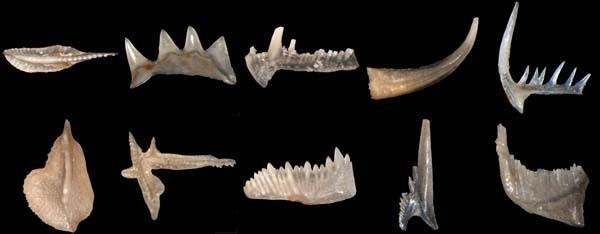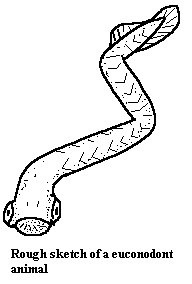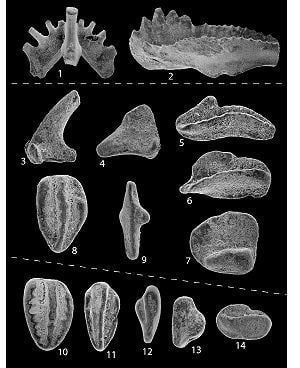Subphylum Vertebrata Higher classification Vertebrate | Scientific name Conodonta Rank Class | |
 | ||
Similar Graptolithina, Brachiopod, Trilobite, Vertebrate, Ostracod | ||
Hitler finds out that conodonts are extinct
Conodonts (Greek kōnos, "cone", + odont, "tooth") are extinct agnathan chordates resembling eels, classified in the class Conodonta. For many years, they were known only from tooth-like microfossils found in isolation and now called conodont elements. Knowledge about soft tissues remains limited. The animals are also called Conodontophora (conodont bearers) to avoid ambiguity.
Contents
- Hitler finds out that conodonts are extinct
- Conodont
- Geological history
- Description
- Elements
- Multielement conodonts
- Elements of ozarkodinids
- Ecology
- Classification and phylogeny
- Taxonomy
- References

Conodonts are considered index fossils, fossils used to define and identify geologic periods.
Conodont
Geological history

The conodonts first appeared during the Cambrian Stage 2 (also referred as Tommotian). The still unnamed Cambrian Stage 10 can be defined as the first appearance of Eoconodontus notchpeakensis. The upper boundary is defined as the appearance of Iapetognathus fluctivagus which marks the beginning of the Tremadocian and is radiometrically dated as 485.4 ± 1.9 million years ago.
The Cambrian–Ordovician extinction event occurred approximately 488 million years ago. This early Paleozoic extinction event extirpated many conodonts.

The Lau event, about 420 million years ago, a relatively minor mass extinction during the Silurian period, had a major impact on conodont populations.

The Kačák Event was a period of significant extinctions. The group most affected was the Ammonoidea, although there were also faunal turnovers amongst conodonts and dacryoconarids.

The entire class is postulated to have been wiped out in the Triassic–Jurassic extinction event, which occurred roughly 200 million years ago. Near the end of the Triassic deadly marine biocalcification began to occur, along with oceanic acidification, sea-level fluctuations and the Central Atlantic Magmatic Province (CAMP) releasing carbon dioxide, sulfur dioxide and aerosols. These environmental catastrophes caused the extinction of the conodonts, along with 34% of other marine genera.
Description
The 11 known fossil imprints of conodont animals record an eel-like creature with 15, or more rarely, 19 elements that form a bilaterally symmetrical array in the head.
The organisms range from a centimeter or so to 40 cm (Promissum) in length. It is now widely agreed that conodonts had large eyes, fins with fin rays, chevron-shaped muscles and a notochord.
Elements
Conodont teeth are the earliest found in the fossil record. The evolution of mineralized tissues has been puzzling for more than a century. It has been hypothesized that the first mechanism of mammalian tissue mineralization began either in the oral skeleton of conodont or the dermal skeleton of early agnathans.
The element array constituted a feeding apparatus that is radically different from the jaws of modern animals. They are now termed "conodont elements" to avoid confusion. The three forms of teeth, i.e., coniform cones, ramiform bars, and pectiniform platforms, probably performed different functions.
For many years, conodonts were known only from enigmatic tooth-like microfossils (200 micrometers to 5 millimeters in length), which occur commonly, but not always in isolation, and were not associated with any other fossil. Until the early 1980s, conodont teeth had not been found in association with fossils of the host organism, in a konservat lagerstätte. This is because most of the conodont animal was soft-bodied, thus everything but the teeth was unsuited for preservation under normal circumstances.
These microfossils are made of hydroxylapatite (a phosphatic mineral). The conodont elements can be extracted from rock using adequate solvents.
They are widely used in biostratigraphy. Conodont elements are also used as paleothermometers, a proxy for thermal alteration in the host rock, because under higher temperatures, the phosphate undergoes predictable and permanent color changes, measured with the conodont alteration index. This has made them useful for petroleum exploration where they are known, in rocks dating from the Cambrian to the Late Triassic.
Multielement conodonts
The conodont apparatus may comprise a number of discrete elements, including the spathognathiform, ozarkodiniform, trichonodelliform, neoprioniodiform, and other forms.
In the 1930s, the concept of conodont assemblages was described by Hermann Schmidt and by Harold W. Scott in 1934.
Elements of ozarkodinids
The feeding apparatus of ozarkodinids is composed at the front of an axial Sa element, flanked by two groups of four close-set elongate Sb and Sc elements which were inclined obliquely inwards and forwards. Above these elements lay a pair of arched and inward pointing (makellate) M elements. Behind the S-M array lay transversely oriented and bilaterally opposed (pectiniform, i.e. comb-shaped) Pb and Pa elements.
Ecology
The "teeth" of some conodonts have been interpreted as filter-feeding apparatuses, filtering plankton from the water and passing it down the throat. Others have been interpreted as a "grasping and crushing array". The lateral position of the eyes makes it unlikely that conodonts were active predators. The preserved musculature suggests that some conodonts (Promissum at least) were efficient cruisers, but incapable of bursts of speed.
Classification and phylogeny
As of 2012, scientists classify the conodonts in the phylum Chordata on the basis of their fins with fin rays, chevron-shaped muscles and notochord.
Milsom and Rigby envision them as vertebrates similar in appearance to modern hagfish and lampreys, and phylogenetic analysis suggests they are more derived than either of these groups. However, this analysis comes with one caveat: early forms of conodonts, the protoconodonts, appear to form a distinct clade from the later paraconodonts and euconodonts. Protoconodonts likely represent a stem group to the phylum that includes chaetognath worms; this conclusion suggests that chaetognaths are not close relatives of true conodonts. Moreover, some analyses do not regard conodonts as either vertebrates or craniates, because they lack the main characteristics of these groups.
Taxonomy
Conodonta taxonomy based on Sweet & Donoghue and Mikko's Phylogeny Archive
Conodonta Pander 1856 non Eichenberg 1930 sensu Sweet & Donoghue 2001 [Conodontia; Conodontophorida Eichenberg 1930; Conodontochordata]
